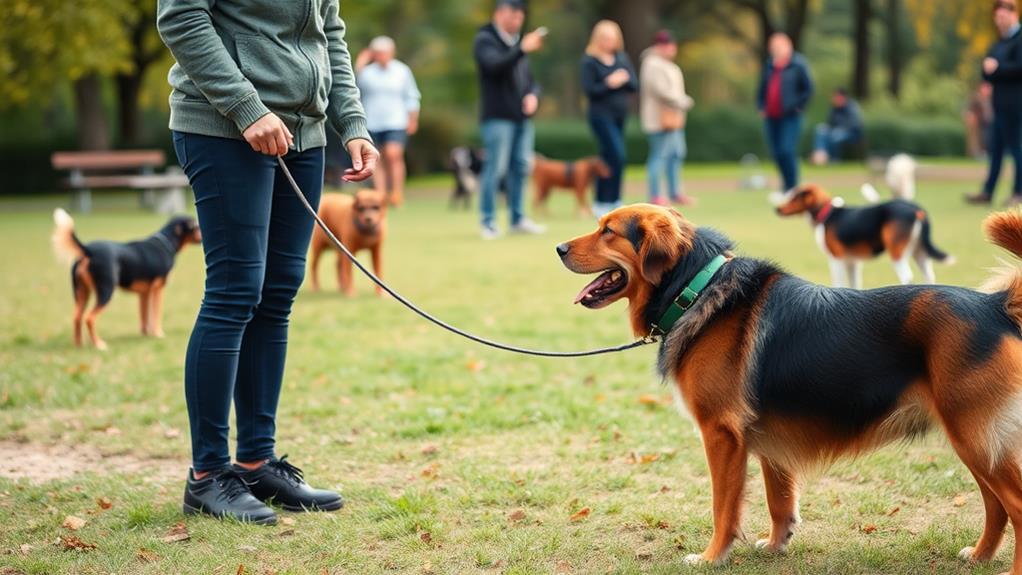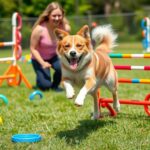To train your reactive dog effectively, start by understanding their triggers—observe their reactions to different situations. Use positive reinforcement to reward calm behavior and avoid harsh corrections. Implement desensitization techniques by gradually exposing your dog to triggers at a distance while rewarding them for staying calm. Establish a calm environment and practice basic commands like sit, stay, and come regularly. If you're struggling, seek professional help from trainers who use positive methods. With these strategies, you can make meaningful progress. Discover even more ways to enhance your training journey ahead!
Understand Your Dog's Triggers
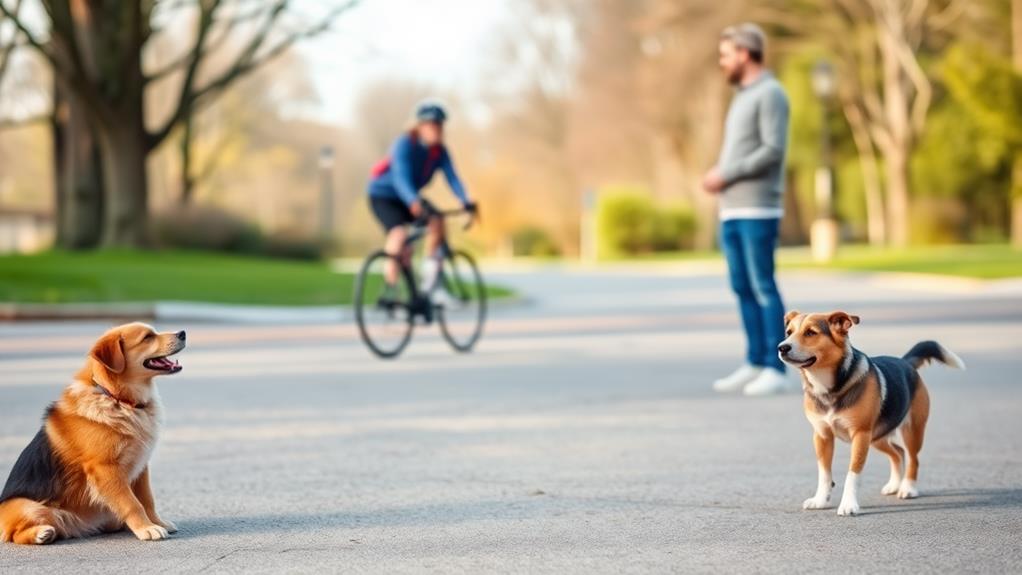
Understanding your dog's triggers is essential for effective training. Every dog has specific stimuli that provoke a reactive response, and identifying these triggers can substantially improve your approach. Start by observing your dog in various situations—notice when they become anxious, aggressive, or overly excited. Common triggers include other dogs, strangers, loud noises, or specific environments.
Once you've pinpointed the triggers, you can create a plan that addresses them directly. For instance, if your dog reacts to other dogs during walks, consider changing your route to avoid busy areas. Gradually expose your dog to their triggers from a distance they can comfortably handle, then slowly decrease that distance over time.
Keep a journal to track your dog's reactions and progress. This can help you spot patterns and adjust your training accordingly. If you notice consistent reactions to a particular trigger, it might be helpful to consult a professional trainer who specializes in reactive dogs.
Use Positive Reinforcement
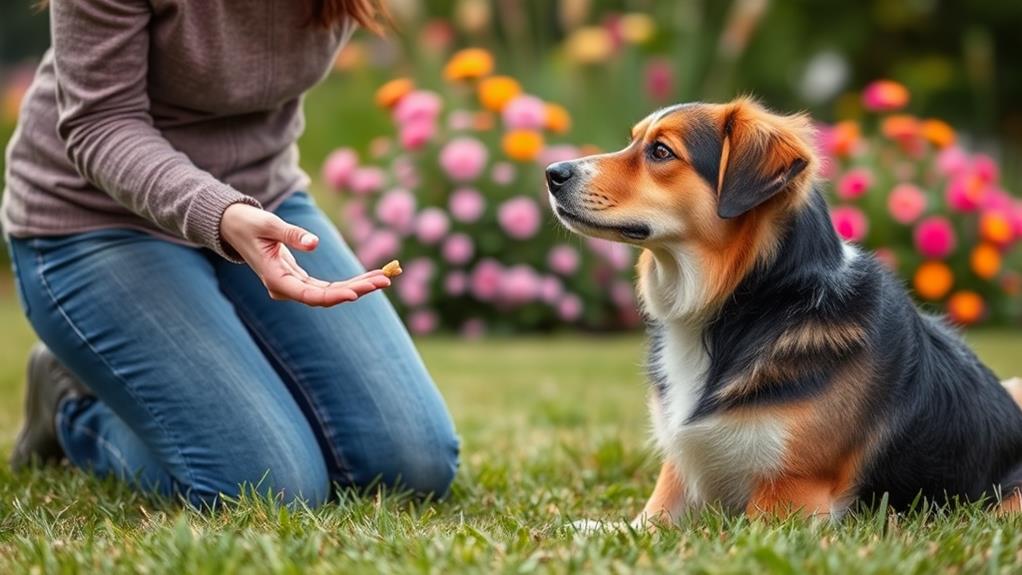
Using positive reinforcement is one of the most effective ways to train a reactive dog. This approach focuses on rewarding your dog for desirable behaviors rather than punishing them for unwanted ones. When your dog reacts calmly in a situation that usually triggers them, immediately offer a treat or praise. This helps them associate the trigger with positive outcomes.
Start by identifying moments when your dog shows calm behavior, even if it's just for a few seconds. Be consistent with your rewards — the more you reinforce these moments, the more likely your dog will repeat them. It's crucial to use high-value treats that your dog truly enjoys, as this will motivate them to focus on you instead of the trigger.
Avoid using harsh corrections or negative reinforcement, as these can increase your dog's anxiety and worsen their reactivity. Instead, aim for a supportive environment where your dog feels safe and understood. Remember, patience is key; training takes time. Celebrate small victories, and don't rush the process. With dedication and positive reinforcement, you'll help your reactive dog become more confident and well-adjusted.
Implement Desensitization Techniques
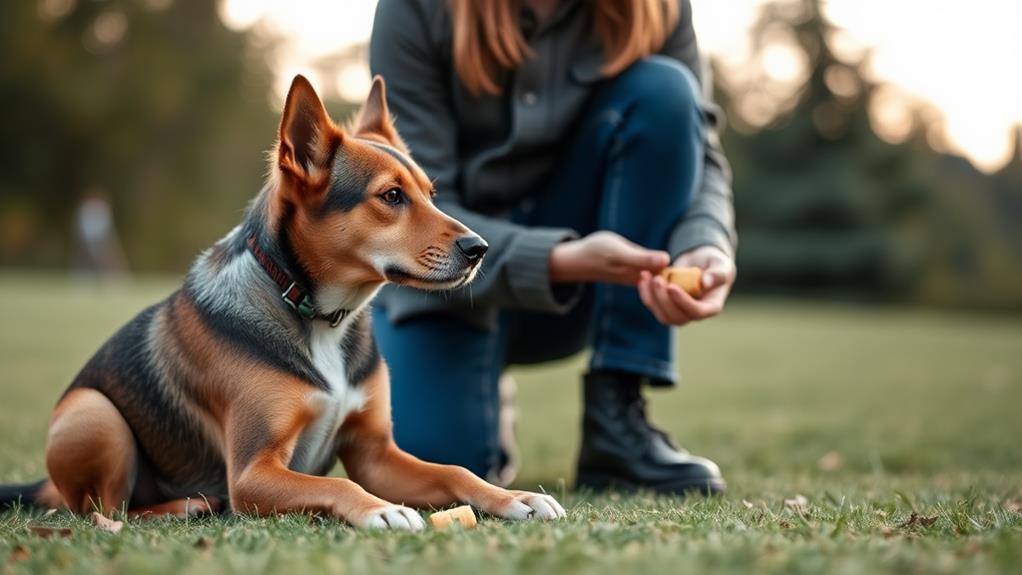
To help your reactive dog become more comfortable in triggering situations, implementing desensitization techniques can be highly effective. This process involves gradually exposing your dog to the stimuli that cause their reactivity while keeping the experiences positive and manageable. Start with low-level exposure to the trigger, such as a distant sight or sound, where your dog feels safe and calm.
As your dog shows signs of comfort, slowly increase the intensity of the exposure. For example, if your dog reacts to other dogs, begin by observing them from a distance. Reward your dog with treats and praise for remaining calm during these encounters. This reinforces their positive association with the trigger.
It's indispensable to monitor your dog's body language throughout this process. If they show signs of stress, you may need to step back and reduce the intensity of the exposure. Patience is key; desensitization can take time, but consistent practice will help your dog build confidence. Remember, the goal is to change your dog's emotional response to the trigger, making them feel more secure and less reactive in the long run.
Practice Controlled Exposures
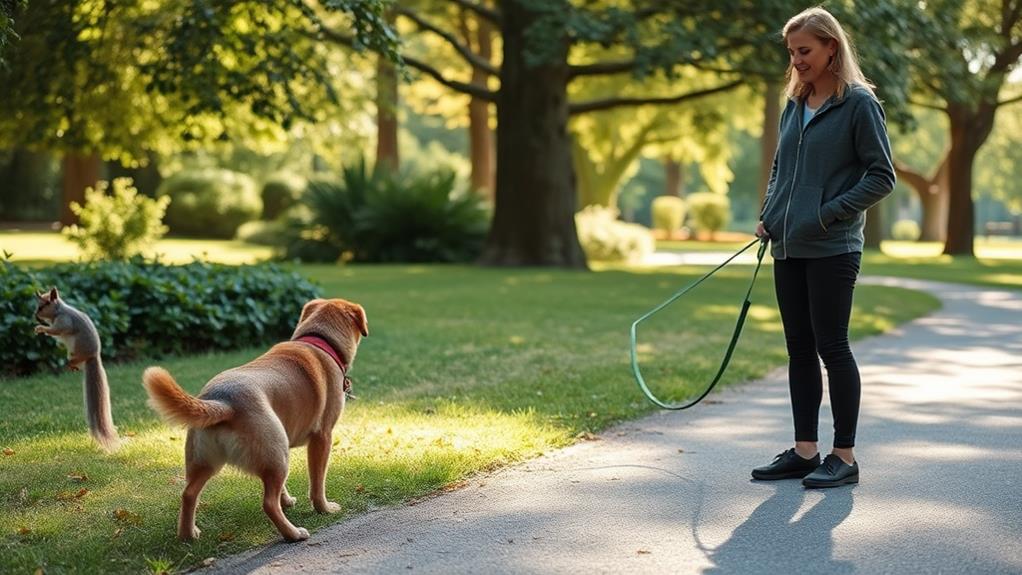
Practicing controlled exposures is crucial for helping your reactive dog learn to manage their responses in real-life situations. By gradually introducing your dog to the triggers that cause their reactivity, you can help them build confidence and learn appropriate behaviors.
Here's how to effectively practice controlled exposures:
- Choose a Safe Distance: Start by finding a location where your dog can see the trigger (like another dog or person) from a distance that doesn't provoke a reaction.
- Use High-Value Treats: Bring along some of your dog's favorite treats. Reward them for staying calm and focused on you when they see the trigger.
- Gradually Decrease the Distance: As your dog becomes more comfortable, slowly decrease the distance between them and the trigger. Monitor their body language to guarantee they're still relaxed.
- Increase Exposure Time: Once your dog can handle being near the trigger, gradually extend the time they spend exposed to it. This helps reinforce positive associations with the situation.
Controlled exposures help your reactive dog learn to remain calm and responsive, paving the way for more successful interactions in the future.
Establish a Calm Environment
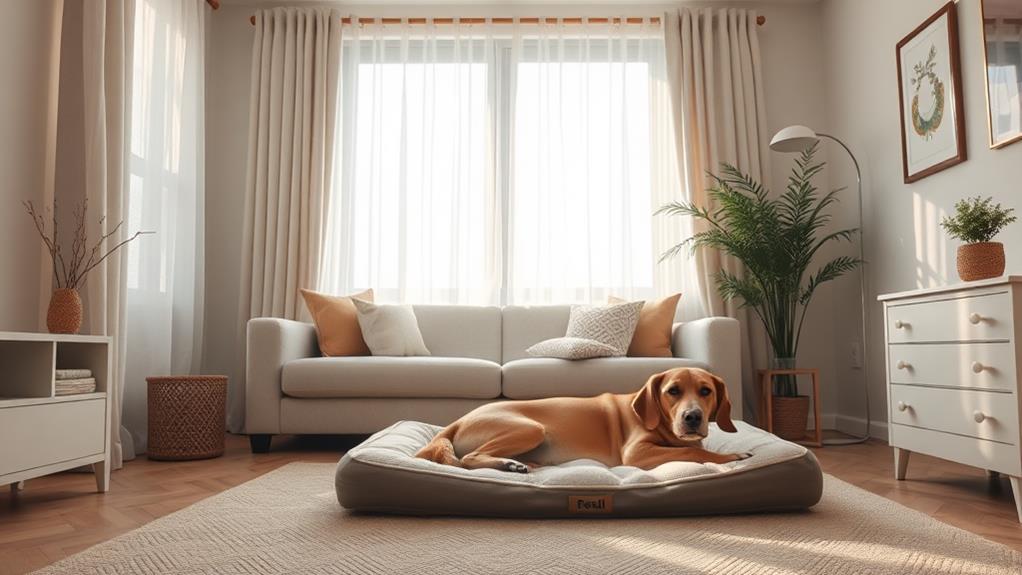
Creating a calm environment is essential for managing your reactive dog's behavior. Start by minimizing distractions in your dog's space. Keep noise levels low and avoid chaotic situations that could trigger anxiety. A quiet room with familiar scents can help your dog feel safe and secure.
Next, consider the layout of your home. Arrange furniture to create a cozy, inviting area where your dog can retreat when feeling overwhelmed. Use calming aids, like soft blankets or beds, to encourage relaxation. Guarantee your dog's favorite toys are within reach, providing comfort when needed.
Additionally, establish a consistent routine. Dogs thrive on predictability, so feeding, walking, and playtimes should happen around the same time each day. This stability helps reduce stress and anxiety.
You should also be mindful of your own energy. Your dog can pick up on your emotions, so staying calm and composed during tense moments is pivotal. Practice deep breathing or engage in calming activities to maintain a peaceful atmosphere. By creating a serene environment, you're setting the stage for more effective training and fostering a stronger bond with your reactive dog.
Work on Basic Commands
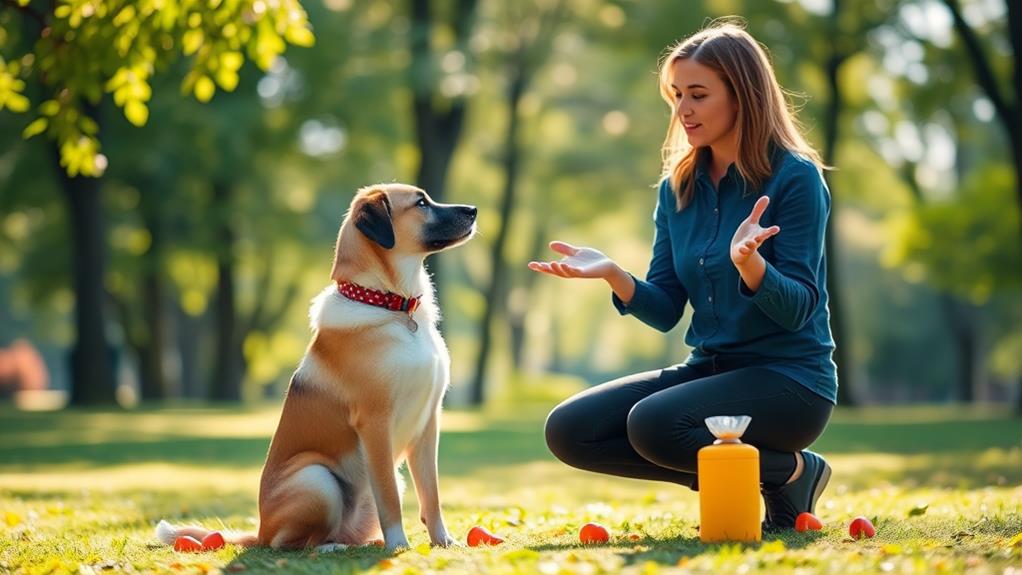
Building a strong foundation with basic commands can tremendously benefit your reactive dog. These commands not only improve communication between you and your dog but also help manage their behavior in stressful situations. By teaching your dog to respond to basic commands, you can redirect their focus and reduce reactivity.
- Sit: This command helps your dog stay calm and focused, which is indispensable in reactive situations.
- Stay: Teaching your dog to stay can prevent them from lunging or reacting to distractions while you maintain control.
- Come: A reliable recall is essential for keeping your dog safe and reducing reactivity when they encounter triggers.
- Leave it: This command teaches your dog to ignore distractions, helping them to avoid reacting to other dogs, people, or objects.
Consistent practice is key. Use positive reinforcement, like treats or praise, to encourage your dog's progress. Remember, patience is crucial, and breaking down training into shorter sessions can keep your dog engaged. With time and dedication, these commands will empower you to manage your reactive dog's behavior effectively.
Seek Professional Help
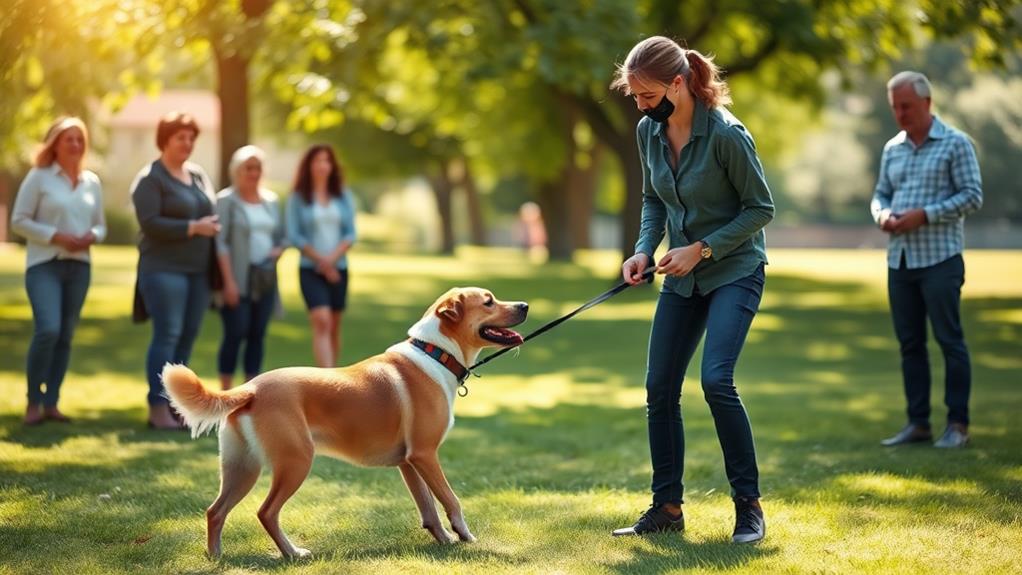
When you're feeling overwhelmed by your reactive dog's behavior, seeking professional help can be a game changer. A qualified dog trainer or behaviorist can provide you with tailored strategies that address your specific situation. They've the experience and knowledge to assess your dog's triggers and reactions, allowing them to create a customized training plan.
Don't hesitate to ask for referrals from friends, veterinarians, or local pet organizations. Look for trainers who use positive reinforcement methods, as these techniques are generally more effective and humane. Once you've found a potential trainer, schedule an initial consultation to discuss your concerns and observe their training style. This step is pivotal; you want to ensure you and your dog feel comfortable with their approach.
During training sessions, stay engaged and proactive. Ask questions and express your thoughts on the techniques being used. Remember, consistency is essential, so work together with your trainer to implement the strategies at home. With professional guidance, you'll gain confidence in managing your reactive dog's behavior, leading to a more harmonious relationship between you and your furry friend. Don't underestimate the value of expert help—it can greatly improve your training journey.
Frequently Asked Questions
How Long Does It Take for a Reactive Dog to Improve?
It often depends on the individual dog and the consistency of your training. Some may improve within weeks, while others might take months. Stay patient, keep practicing, and celebrate the small victories along the way!
Can I Train a Reactive Dog Without Using Treats?
Yes, you can train a reactive dog without treats. Focus on praise, play, and consistent commands. Use positive reinforcement methods that don't involve food, ensuring you build a strong bond and motivate your dog effectively.
What Are Some Common Mistakes to Avoid During Training?
During training, avoid common pitfalls like impatience, inconsistency, and neglecting your dog's signals. Stay steady, stay supportive, and stay focused. Remember, training takes time, so don't rush; celebrate small successes along the way!
Should I Socialize My Reactive Dog With Other Pets?
Socializing your reactive dog with other pets can be beneficial, but it's essential to do so gradually. Start with controlled environments and monitor interactions closely to guarantee safety and comfort for everyone involved.
How Can I Manage My Dog's Reactivity in Public Spaces?
Managing your dog's reactivity in public spaces can feel formidable. Start by keeping distance from triggers, using treats to redirect focus, and gradually exposing them to new environments. Consistency will lead to progress, trust me.
Conclusion
Training a reactive dog takes patience and consistency, but it's worth it for a happier, calmer pet. Did you know that about 30% of dogs exhibit some form of reactivity? By understanding your dog's triggers and using positive reinforcement, you can make a real difference in their behavior. Remember, establishing a calm environment and practicing basic commands are key steps. Don't hesitate to seek professional help if needed—your furry friend deserves a peaceful life!

